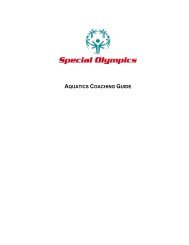BADMINTON Special Olympics Sports Skills Program
BADMINTON Special Olympics Sports Skills Program
BADMINTON Special Olympics Sports Skills Program
You also want an ePaper? Increase the reach of your titles
YUMPU automatically turns print PDFs into web optimized ePapers that Google loves.
Initial Measures for Cardiac Arrest<br />
Always have someone familiar with basic life support and<br />
cardiopulmonary resuscitation (CPR) at every training<br />
session. Even though the possibility of cardiac arrest is<br />
much greater among the spectators than among the athletes,<br />
it is always possible. Initial steps include the following:<br />
• CALL EMS (your local Emergency Medical System).<br />
• Establish unresponsiveness.<br />
• Call out for assistance.<br />
• Position the victim (only in life-threatening situations<br />
should you move or reposition the athlete).<br />
Recommended Emergency Medical Procedures<br />
1. DO NOT MOVE an athlete who is believed to be<br />
seriously injured…especially when a head, neck, or back<br />
injury is suspected.<br />
2. A responsible person must STAY WITH THE<br />
INJURED ATHLETE at all times and have the "<strong>Special</strong><br />
<strong>Olympics</strong> Application for Participation" (medical form)<br />
and the "Athlete/Parent Release" form available. He or<br />
she must also provide appropriate emergency support.<br />
A second person needs to stay with the other athletes.<br />
3. Another responsible person should CALL THE<br />
EMERGENCY MEDICAL ASSISTANCE NUMBER<br />
(911) and meet the paramedics. This will enable them to<br />
come as quickly as possible and to enter the area at the<br />
designated place.<br />
4. The rest of the coaches should be with the other athletes,<br />
moving them to another area and assuring them that<br />
appropriate emergency procedures are being followed.<br />
It is also a good opportunity to answer their questions<br />
and concerns about their teammate.<br />
5. Contact the parent and caregiver as soon as possible.<br />
ABCs of CPR<br />
These are simply reminders for those who are already<br />
trained in CPR. You should only attempt CPR if you are<br />
trained or there is no one else around and advanced medical<br />
help is on the way.<br />
4 6<br />
Call Emergency Medical System<br />
Airway<br />
• Open airway (tilt head and lift chin).<br />
• Establish breathlessness (look, listen, feel).<br />
Breathing<br />
• Check for foreign body (airway obstruction).<br />
• Provide mouth to mouth breathing.<br />
Circulation<br />
• Check for pulse.<br />
• Start chest compression (if no pulse is felt).<br />
Heat Related Illnesses<br />
Heat Emergencies<br />
These problems often occur when athletes play too long and<br />
hard or stay too long in the sun. People do not always realize<br />
how the sun can affect them.<br />
Sunburn can occur on overcast days as well as on sunny<br />
days. When athletes are in the sun, they should wear a<br />
water-resistant sunscreen lotion, which provides maximum<br />
protection. Sunglasses and a hat provide added protection.<br />
The following information tells how to recognize and initiate<br />
treatment for heat stroke, heat exhaustion, and heat cramps.<br />
Heat Stroke<br />
Signs and symptoms<br />
• Hot, red, dry skin<br />
• Very high body temperature<br />
• Rapid/weak pulse<br />
• Rapid/shallow breathing<br />
• Shock or unconsciousness<br />
What to do<br />
• Treat heat stroke as a life-threatening emergency and<br />
call the paramedics.<br />
• Cool the victim by immersing in a cool bath or<br />
wrapping in wet sheets and fanning.<br />
• Care for shock by laying the victim down and elevating<br />
the feet.<br />
• Give nothing by mouth.<br />
Heat Exhaustion<br />
Signs and symptoms<br />
• Cool, pale, or flushed; moist skin<br />
• Rapid, weak pulse<br />
• Weakness and dizziness<br />
• Nausea and vomiting<br />
What to do<br />
• Treat heat exhaustion as an emergency and call the<br />
paramedics.<br />
• Get the victim into the coolest place available.<br />
• Place the victim on the back with the feet elevated.<br />
• Cool victim by applying wet sheets or towels to the<br />
body and by fanning.<br />
• Give a half-glass of water to drink every 15 minutes<br />
if the victim is fully conscious and can tolerate it.

















